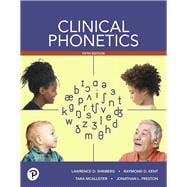If purchasing or renting from companies other than Pearson, the access codes for the Enhanced Pearson eText may not be included, may be incorrect, or may be previously redeemed. Check with the seller before completing your purchase.
This package includes the Enhanced Pearson eText.
A comprehensive introduction to the art and science of applying phonetics to clinical transcription
Clinical Phonetics was written specifically for readers who need to know phonetic knowledge and skills for clinical purposes in speech-language pathology. It covers the basic aspects of the phonetics of American English, including phonetic symbols, articulatory descriptions, and acoustic correlates, but it is unique in offering clinically relevant experience with authentic articulatory descriptions and speech samples from children and adults who have speech disorders or who use regional dialects. A wealth of clinically relevant topics further aids readers in preparing for their own transcription experiences as professionals.
Now featuring the insights and expertise of two new co-authors, the 5th Edition retains its focus on clinical applications while offering more opportunities for clinical transcription, significantly updated content, and an improved organization to maximize clarity and ease of learning.
Improve mastery and retention with the Enhanced Pearson eText*
The Enhanced Pearson eText provides a rich, interactive learning environment designed to improve student mastery of content with embedded video, authentic audio samples, and multiple-choice quizzes with feedback. The Enhanced Pearson eText is:
- Engaging. The new interactive, multimedia learning features were developed by the authors and other subject-matter experts to deepen and enrich the learning experience.
- Convenient. Enjoy instant online access from your computer or download the Pearson eText App to read on or offline on your iPad® and Android® tablet.**
- Affordable. Experience the advantages of the Enhanced Pearson eText along with all the benefits of print for 40% to 50% less than a print bound book.
**The Pearson eText App is available on Google Play and in the App Store. It requires Android OS 3.1-4, a 7” or 10” tablet, or iPad iOS 5.0 or later.
0134683250 / 9780134683256 Clinical Phonetics with Enhanced Pearson eText - Access Card Package
Package consists of:
- 0134695585 / 9780134695587 Clinical Phonetics -- Enhanced Pearson eText -- Access Card
- 0134746147 / 9780134746142 Clinical Phonetics











